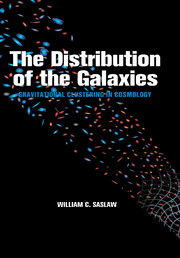Book contents
- Frontmatter
- Contents
- Prologue
- Part I Historical
- Part II Descriptions of Clustering
- Part III Gravity and Correlation Functions
- Part IV Gravity and Distribution Functions
- Part V Computer Experiments for Distribution Functions
- Part VI Observations of Distribution Functions
- 33 Observed Spatial Distribution Functions
- 34 Observed Peculiar Velocity Distribution Functions
- 35 Observed Evolution of Distribution Functions
- Part VII Future Unfoldings
- Bibliography
- Index
35 - Observed Evolution of Distribution Functions
Published online by Cambridge University Press: 19 January 2010
- Frontmatter
- Contents
- Prologue
- Part I Historical
- Part II Descriptions of Clustering
- Part III Gravity and Correlation Functions
- Part IV Gravity and Distribution Functions
- Part V Computer Experiments for Distribution Functions
- Part VI Observations of Distribution Functions
- 33 Observed Spatial Distribution Functions
- 34 Observed Peculiar Velocity Distribution Functions
- 35 Observed Evolution of Distribution Functions
- Part VII Future Unfoldings
- Bibliography
- Index
Summary
I will to be and to know,
facing in four directions,
outwards and inwards in Space,
observing and reflecting,
backwards and forwards in Time,
recalling and forecasting.
AudenThe past is our future frontier. Distribution functions at high redshift have not yet been observed. Therefore this chapter will be very short.
Here and there we have glimpses of how galaxy clustering may have developed. These are from observations of two-particle correlations, Lyman alpha clouds, merging protogalaxies, and rich clusters, all at great distances. Eventually, when the halfdozen or so high-redshift catalogs now being started accumulate complete and well-chosen samples, they will yield up the distribution functions of the past. Insofar as these agree with the GQED, their evolution is represented by the changing of b. Thus there is time for genuine predictions, such as those of (30.12) and (30.19)–(30.20) shown in Figure 30.5. These catalogs will also test the importance of merging, which would alter N's conservation (see Chapter 36).
At high redshifts the value of b for gravitational quasi-equilibrium evolution depends quite strongly on Ω0. igures 30.5, 31.12, and 31.13 indicate that as we look further into the past, b will decrease more slowly for lower Ω0. This is essentially because the clustering pattern is “frozen” at higher redshifts for lower Ω0. Equivalently, for higher Ω0 most of the evolution occurs more recently. Zhan (1989) and Saslaw and Edgar (1999) give useful diagrams to show how this can help determine Ω0 and the redshift at which galaxies start clustering.
- Type
- Chapter
- Information
- The Distribution of the GalaxiesGravitational Clustering in Cosmology, pp. 459 - 462Publisher: Cambridge University PressPrint publication year: 1999



